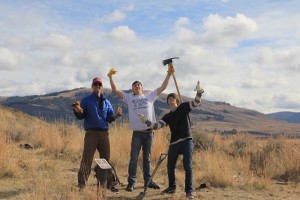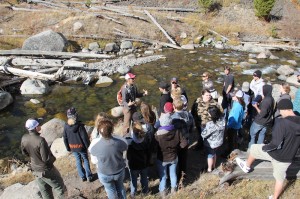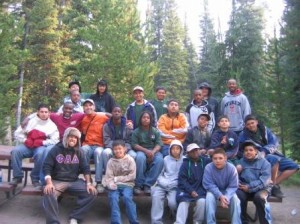When I think of the names that inspired me to seek an Environmental Studies degree at the University of Montana and follow the career and life path I have chosen as a crusader for wild places, I think of names like Abbey, Thoreau, Muir, Carson, Leopold, Brower, and Murie.
One thing all of these people have in common is that they are no longer physically with us. They are dead.
This is a problem.
It is not that we lack inspiring, articulate, dedicated leaders today. Just look at Terry Tempest Williams, David James Duncan, Philippe Cousteau, Harvey Locke, Tom Roy, Rick Bass, Paul Hawken, Wendell Berry and countless others. But there is a shortage of young crusaders leading the charge of another movement in wilderness conservation across Western North America.
I hesitate to even call it a movement today. A movement by nature is something that is active, pulsing, engaging and surging; and these are not adjectives I would use to describe the current state of the wilderness debate.
Though there is creative and meaningful work being done by motivated and passionate people and grassroots organizations all throughout the West, not enough is being done for those of us who love this big, wild, watery, rugged earth to be able to afford to simply sit back and watch. We need to be active, fluid, and engaged; not sitting, watching, and bemoaning.

Stoked participants of YCG’s 2011 Yellowstone Leadership Challenge after successful restoration project in Yellowstone National Park.
We need new blood, new ideas, new language and new people to foster a new surge in what could be a new preservation movement. The movement has been idle it seems for over a decade. The era of environmental laws and action that occurred throughout the ‘60s and into the ‘70s has slowed to a crawl in 2012. After decades of working on behalf of Yellowstone’s bison, through the efforts and leadership of organizations and leaders like Mike Mease from the Buffalo Field Campaign and the wizard of them all, Glenn Hockett, from the Gallatin Wildlife Association, we are finally making progress on the most archaic and senseless of all conservation battles on our Western lands. But a cadre of new blood, crusaders and guardians are needed to ensure the lasting success that has recently been pioneered on behalf of the shaggy behemoths of Yellowstone. We’ve seen wolves successfully restored to the Yellowstone and Central Idaho, with the battle raging hot as a fiery furnace, and in the midst of controversy, a sense of wildness has been returned to an already pulsing landscape.
I do not question the belief that many memorable and lasting achievements have occurred in the last decade; but the movement itself feels stale. The work that continues to inspire and motivate many in the today’s wilderness movement occurred long ago. Today’s wilderness constituency in the Western U.S. resembles a fraternity. It is so dominated by the established and well-entrenched organizations—whose operatives tend to be middle aged, comfortable white folks—that it has become difficult for young people to step into any role of leadership. There is very little new blood and this makes a fresh dialogue a difficult challenge. Instead of polarizing issues, what we need to do is bring a diverse spectrum of western people together. We need to provide a platform for those not typically involved with the wilderness, preservation, conservation movement, and this especially includes our youth and young adults.
Now, there certainly are countless organizations and wildlands enthusiasts who recognize the need for change within the movement. Right here in Montana we have groups like the Sonoran Institute, a national organization with offices in the Treasure State, who understand the importance of broadening the western conservation movement to include and respect both the lands and the communities across this expansive landscape. We also see smaller grass-roots organizations like the Clark Fork Coalition working collaboratively with local communities and a diverse cross-section of interest groups to effectively protect the Clark Fork River basin. During my five years as the director of Yellowstone Country Guardians (a small education-based nonprofit operating in Gardiner, Montana), I observed and worked with the salt-of-the-earth likes of Joe Josephson, a respected ice climber with multiple-generations of history from Big Timber, Montana, now working for the National Parks Conservation Association from their regional Livingston offices, and the “Prophet” JB Klyap, a visionary operational manager of the Dome Mountain Ranch, to connect local youth to critical local conservation issues with impressive results. These are examples of a small army of people and organizations who understand that the fate of our wild lands and wild rivers are directly linked to the health and vitality of our communities.

Local Yellowstone area teens learning about stream ecology during a three day intensive leadership challenge.
When the participants of a lackluster movement resemble members of an elite country club, you don’t have a movement, you have an interest group. The fate of wildlands and the communities across the west should not rest in the hands of one special interest group. Our wild lands and wild rivers are as democratic a resource as we will ever know. They are not the concern of one religious sect or another. They are not Democrat, nor are they Republican. The wild landscapes and wild country spattered across the West constitute a part of our identity and represent who we are as a people and a region. And the thousands of organizations across the area represent both the people and the communities of our western states.
I don’t foresee the current inhabitants of the conservation world welcoming the necessary shift in language and leadership with open arms, which may point toward a need for new organizations, with new names and new founding assemblies, where young people can become the emerging stars—without being stymied by old school politics—take the stage and perhaps inspire a new generation and culture within the movement.
Fresh faces won’t be enough. We need a new dialogue, a new language. We have let the religious right—the evangelicals—highjack sacred language, as stated by David James Duncan in his beautifully crafted book, God Laughs and Plays. As Duncan argues, it’s long overdue that we take back the sacred language. This is the language that can and will inspire a new surge within the conservation movement. Until we believe that our wild rivers, wild forests, wild meadows and valleys, and the wild critters—four legged, winged and finned—are sacred and holy entities, we will continue down the same entrenched path that the current movement—or lack thereof—has been on for a over a decade. We must recognize that the single most important habitat to ensure the survival of our wildest species resides in the human heart.
While the conservation movement desperately needs new voices spreading this gospel, this is not to say that those who have forged the bonds and paved the way for this next generation should simply disappear or go into hiding. A new language, spoken by new voices, may be the spark the movement needs to once again kick-start and inspire people to participate fully in the ultimate quest of fostering support for our communities and citizens (human and otherwise), helping people rediscover a deep and burning love for the land and waters that make us who we are as a nation, and more importantly, as a people. And this can only occur on a sustainable level if the current leaders seriously consider their responsibility to mentor the next generation of wildland advocates.
Perhaps this new movement should receive a new name that is more indicative of its inclusiveness. Just as the wilderness, preservation, and conservation movements grew out of the broader context of the environmental movement, now it is time for yet another chapter. In trying to get the attention of and motivate the next generation of wildland stewards, we must compete with iPhones, iPads, and consumerist marketing campaigns that represent a furious and endless assault on our senses. We will never compete with the latest buzz in technological advancement if we don’t find a way to make the plight of our wild planet relevant and, to a certain degree, edgy. The doom and gloom scare tactics notorious with the greater environmental movement have done little but numb the sympathies of our younger citizens—but I have witnessed firsthand over the last decade the tremendous power of sharing the sighting of a grizzly bear, a wild bison, a bugling elk, a wild brook trout, loping coyote, or flock of Canada geese with rural Montana youth or urban teens from our largest metro areas. A sense of awe, wonder and responsibility unfolds with each encounter. And that is key—for we only fight to save what we love. And we only love what we know. While nothing compares to a firsthand encounter with a four-legged in wild country, I’ve witnessed similar responses when visiting classrooms in Farmville, Virginia, and planetariums in San Francisco, California. In order for the next generation to become engaged, we must first get their attention. Be it a backcountry hike, a visit to a planetarium, or a powerful presentation, we need to provide a fertile environment that resonates somewhere deep within each young person’s soul.
In our approach to inspiring a new wave to create tangible and lasting change on the ground, we must be audacious. Perhaps we should call it the Audacious Guardian Movement. I’m not sure the name matters, but the intention must be absolute. This movement must emphasize the importance of the human element and recognize the need to work broadly to foster healthy communities, full of vigor, within and surrounding our wildlands.
The old guard has to remain a vital part of the movement, mentoring the fresh faces that are needed to shake things up and excite change within our culture. Artificial change has dominated the discussion for far too long. Now is the time to create real change—dramatic and lasting—and this will surely begin in the place where all great change has historically occurred: the hearts and minds of the populace. Without guidance and mentoring this will not occur, or it may occur too late. For the spark to be ignited, the old guard needs to take seriously the task of nurturing the development of the next generation. Right here, right now is the time, the evolution, the changing of an era. This is the time we will all look back upon fondly, just as generations today speak of the golden age of the conservation movement.

Inspired cadre of Los Angeles youth on wilderness retreat to Yellowstone National Park through Atlanta based C5 Youth Foundation’s insanely impactful summer program.
Until we figure out how to inspire and include the owners of the gas station in Cody, Wyoming, the ranch kid in the Paradise Valley, Montana, the Hispanic workers in Nampa, Idaho, and the inner city kids of Boise, Billings, Seattle, Spokane, Portland and Los Angeles, we cannot truly be a success. We need to build bridges across landscapes traditionally as large as Montana. Wilderness organizations have to come together with the common goal of bettering the world we live in versus bettering the bank account of the organization. Both can and will occur if we work together. We can raise funds while working with—not against—the organizations that were traditionally thought of as competition, and use those funds to create desperately needed change.
It is high time to broaden the conservation, preservation and wilderness components of the environmental movement so many care desperately about. We need a transformation within the movement and that transformation has to be the antithesis of today’s conservation environment. The movement is far from lifeless, but until we learn how to give breath to more love, passion, and fire in the movement, it will remain placid, in hibernation. It is time to for a new generation to seize the moment, be audacious and awaken to a bright new world, a new beginning powered by hope, love, and passion.
We can learn from the recent boom in the business of the evangelical church. People want to believe in something and they want to believe in something profoundly. What better to believe in than the land and waters that sustain us all? We can create a groundswell of a movement, relight the fire, rediscover the passion; but we can’t do it speaking the same language to the same old crowd. The old guard are needed for their expertise and mentoring. But these voices are no longer enough.
Young people cannot take “no” for an answer. We have to pound down the doors and break down the barriers until we get ourselves into positions of leadership. Only then can we foster a new movement within the movement—not to replace, but to rebuild, to rediscover. Therein lies the future. If we dare to dream it, hope it, and believe it, we can once again become a powerful force. The day when people of all ages, colors, and backgrounds come together collectively and mobilize forces is the day we will inspire a new surge in a historic movement that will forever change the world.
~Michael Leach

Wonderful piece Mike and a real call to action! We need to inject new energy and passion to mobilize all citizens of planet Earth to protect what we have. Through fostering stewardship with younger generations, integrating technology, passion, and trust we can build a sustainable future. Be Audacious and surge!
This is such a powerful, bold, and dare I say, “audacious” message Rev! And your photos really demonstrate that what you strive for can be, and is being, done, thanks to your determined dedication. You know what I see in those photos? Diversity, AND celebration. Keep bringing everyone together Rev. If anyone can do it, you can.